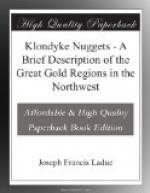“Many years ago, sixteen I think, a man named Monroe prospected up the Taku and learned from the Indians something of a large lake not far from that river. He crossed over and found it, and spent some time in prospecting, and then recrossed to the sea. This man had been at Forty Mile River, and I heard from the miners there his account of the appearance of the lake, which amounted generally to this: The Boswells did not know anything about it.” It was unfortunate the Boswells did not remain at Forty Mile all winter, as by a comparison of recollections they might have arrived at some correct conclusion.
“Conflicting as these descriptions are, one thing is certain: this branch, if it has not the greater discharge, is the longer and more important of the two, and offers easy and uninterrupted navigation for more than double the distance which the Lewes does, the canon being only ninety miles above the mouth of the Teslintoo. The Boswells reported it as containing much more useful timber than the Lewes, which indeed one would infer from its lower altitude.
“Assuming this as the main river, and adding its length to the Lewes-Yukon below the junction, gives upward of 2,200 miles of river, fully two-thirds of which runs through a very mountainous country, without an impediment to navigation.
“Some indefinite information, was obtained as to the position of this river in the neighborhood of Marsh Lake tending to show that the distance between them was only about thirty or forty miles.
“Between the Teslintoo and the Big Salmon, so called by the miners, or D’Abbadie by Schwatka, the distance is thirty-three and a-half miles, in which the Lewes preserves a generally uniform width and current. For a few miles below the Teslintoo it is a little over the ordinary width, but then contracts to about two hundred yards which it maintains with little variation. The current is generally from four to five miles per hour.
“The Big Salmon I found to be about one hundred yards wide near the mouth, the depth not more than four or five feet, and the current, so far as could be seen, sluggish. None of the miners I met could give me any information concerning this stream; but Dr. Dawson was more fortunate, and met a man who had spent most of the summer of 1887 prospecting on it. His opinion was that it might be navigable for small stern-wheel steamers for many miles. The valley, as seen from the mouth, is wide, and gives one the impression of being occupied by a much more important stream. Looking up it, in the distance could be seen many high peaks covered with snow. As the date was August it is likely they are always so covered, which would make their probable altitude above the river 5,000 feet or more.
“Dr. Dawson, in his report, incorporates fully the notes obtained from the miners. I will trespass so far on these as to say that they called the distance to a small lake near the head of the river, 190 miles from the mouth. This lake was estimated to be four miles in length; another lake about 12 miles above this was estimated to be twenty-four miles long, and its upper end distant only about eight miles from the Teslintoo. These distances, if correct, make this river much more important than a casual glance at it would indicate; this, however, will be more fully spoken of under its proper head.




